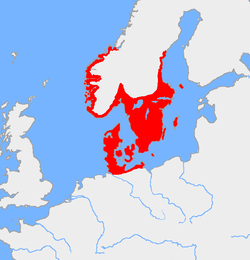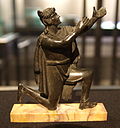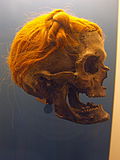Germanic peoples
The Germanic peoples are a linguistic and ethnic branch of Indo-European peoples. They came from Northern Europe and are identified by their use of the Germanic languages. During the migration period Germanic peoples spread throughout Europe, mixing with existing local populations (like Celts, Slavs/Vends, and Romans). They eventually formed the basis of many nations. These nations are connected by similar languages, common history, and culture.
The Latin word Germani was first used by Julius Caesar.
The Germanic tribes did not have a name for themselves that described all Germanic-speaking people. In English, German is first attested in 1520, replacing earlier use of Almain or Dutch. Today, in English, “Dutch” means the language or people of the Netherlands.
In the 1st century CE, Roman authors like Caesar and Tacitus wrote that Germanic-speaking peoples had divided into tribal groupings. The different tribes lived in different areas:
- The East Germanic tribes lived around the rivers Oder and Vistula, in what is now Poland.
- The Istvaeones lived around the lower Rhine River.
- The Irminones lived around the Elbe River, in what is now Germany.
- The Ingvaeones lived in Jutland and other islands that now belong to Denmark.
The Irminones, Ingvaeones, and Sons of Mannus Istvaeones are called West Germanic tribes. The Germanic people who remained in Scandinavia called North Germanic. The groups all developed separate dialects, which eventually developed into different Germanic languages.
The Germanic peoples did not call themselves West Germanic, East Germanic, or North Germanic. Those categories were created in modern times.
Each Germanic tribe was politically independent, under a hereditary king. Each tribe had a myth about who first created the tribe. For example, myths stated:
- Angul created the Angles
- Aurvandil created the Vandals (though historians are not certain this actually happened)
- Burgundus created the Burgundians
- Cibidus created the Cibidi
- Dan created the Danes
- Nór created the Norwegians
- Gothus created the Goths
- Ingve created the Ynglings
- Irmin created the Irminones
- Longobardus created the Lombards
- Saxneat created the Saxons
- Valagothus created the Valagoths
- Suiones created the Swedes (Svear)
Some Germanic kings claimed that they should have power because they were related to their tribe’s mythical founders.
Origin
The early Germanic tribes spoke different dialects, but could understand each other. They shared a common culture and mythology (see Germanic mythology). Beowulf and the Volsunga saga make this clear.
At this time, the Romans forced the different peoples of Italy to be part of one big empire. Unlike Italy, no large empire forced Germanic people to unite. Because of this, the various tribes remained free, led by their own hereditary or chosen leaders.
Germanic Peoples Media
Roman bronze statuette dated to the late 1st century – early 2nd century CE, representing a Germanic man with his hair in a Suebian knot
The approximate positions of the three groups and their sub-peoples reported by Tacitus:* Suebi (part of the Herminones)* Other Herminones
The inscription on the Negau helmet B, carved in the Etruscan alphabet during the 3rd–2nd c. BCE, is generally regarded as Proto-Germanic.
Replica of an altar for the Matrons of Vacallina (Matronae Vacallinehae) from Mechernich-Weyer, Germany
Iron Age: Orange Field – La Tène culture (Celtic), Dark Red – Jastorf culture (Germanic), Dark Green – Iron Age Scandinavia (Germanic)
The Roman province of Germania, in existence from 7 BCE to 9 CE. The dotted line represents the Limes Germanicus, the fortified border constructed following the final withdrawal of Roman forces from Germania.
A bog body, the Osterby Man, displaying the Suebian knot, a hairstyle which, according to Tacitus, was common among Germanic warriors[1]
Other websites
- Germanic Roots of Great Britain, A Genetic Study
- On the origins of Anglo-Saxons
- Anglo-Saxons and Britons
- ↑ Steuer 2021, p. 683.











